Are you looking for creative and functional daycare room setup ideas? As a daycare provider or considering starting daycare, creating a safe and fresh environment is key to providing quality care for children. We will explore creative and functional ideas to help you optimize your daycare room setup.
Daycare room setup ideas can range from vibrant color schemes and interactive learning centers to versatile furniture arrangements and storage solutions to spark children’s imaginations and enhance their learning experience. Bring the outdoors into a nature-inspired theme or create themed reading corners to foster a love of books from an early age. Utilize wall decals and sensory elements to promote sensory development and exploration. Incorporate interactive displays and bulletin boards to showcase children’s artwork, accomplishments and classroom goals.
Each setting encourages cognitive development, social interaction and endless fun. No matter the size of your daycare center, you’ll find ideas that can be adapted to fit any space and budget.
Remember, every detail counts when thinking about daycare room setup ideas. With our expertise in childcare, we’ve curated ten of the best daycare room setup ideas that strike the perfect balance between function and imagination.
What Are the Essential Elements of Daycare Room Setup Ideas?
When designing a daycare room, functionality must align with the developmental needs of children. Key elements include:
- Safety: Ensuring all furniture and play areas meet safety standards is crucial. Check regularly for potential hazards and maintain a clear and organized space.
- Flexibility: Furniture should be lightweight and easy to move. This allows for quick changes in the room layout to suit different activities and group sizes.
- Accessibility: Children should be able to access toys, books, and materials independently. This encourages self-directed learning and exploration.
- Comfort: Areas for rest and quiet time are important. Comfortable seating and a cozy atmosphere help children relax and recharge.
- Stimulation: Various colors, textures, and materials can stimulate sensory experiences and creativity. Educational posters and interactive walls also contribute to a stimulating environment.
- Storage: Ample storage solutions help keep the room tidy and organized. Well-planned storage allows easy access and helps children learn to put things away.
Daycare Room Setup Ideas
The right daycare room setup ideas optimize space and enhance learning and play. Effective setups include flexible furniture arrangements, safe play areas and zones dedicated to different activities to ensure a rich and varied experience for children.
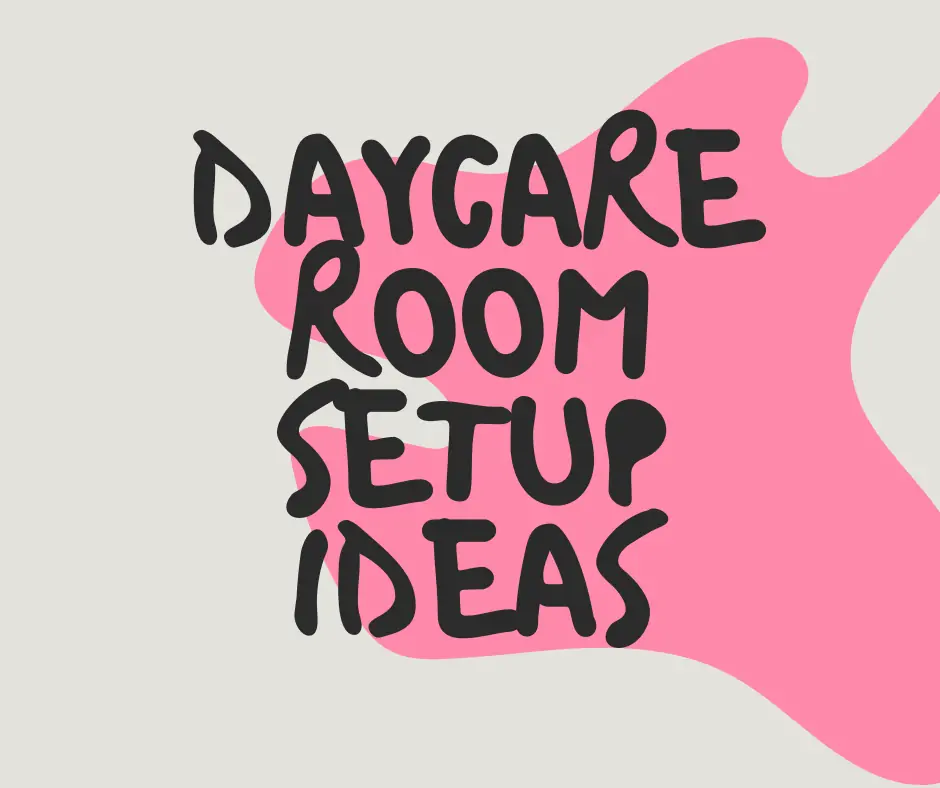
1. Age-appropriate Daycare Furniture and Equipment
Choosing age-appropriate daycare furniture and equipment creates a safe and conducive learning environment when setting up a daycare room. Make sure everything in the room is accessible and appropriate for your child’s stage of development. Here’s what you need to consider:
- Safety First: Choose furniture with rounded corners and stable structures to prevent accidents.
- Right Size: Furniture should be scaled down to a size children can easily access without help.
- Encourage Movement: Include lightweight pieces that children can rearrange to promote independence and physical activity.
- Material Matters: Opt for non-toxic, easy-to-clean materials that can withstand rough use and are environmentally friendly.
- Engagement Through Design: Use bright colors and interactive elements like built-in puzzles or writable surfaces to foster engagement and creativity.
- Play Equipment: Select age-appropriate playground equipment, such as soft blocks for toddlers and more complex play sets for older children, to help develop motor skills and encourage creativity.
- Safety Gear: Include equipment like child-proof locks, safety gates, and corner protectors to prevent accidents.
By integrating these elements, you ensure the furniture not only fits the physical requirements of children but also aids their development and safety.
2. Daycare Room Setup Ideas: Create Designated Interest Areas
Designated interest areas within a daycare encourage children to explore different activities and interact with varied educational materials. These areas should be clearly defined and organized to attract and hold children’s attention. Here’s how to set them up effectively:

Napping Area
Create a tranquil, comfortable space with cozy cots, soft bedding, and calming lights, ensuring it is isolated from noisier activity areas to facilitate undisturbed rest.
Feeding Area
Ensure that mealtimes are enjoyable and uncluttered by designing a hygienic, safe, and organized eating area with easy-to-clean surfaces and appropriate seating.
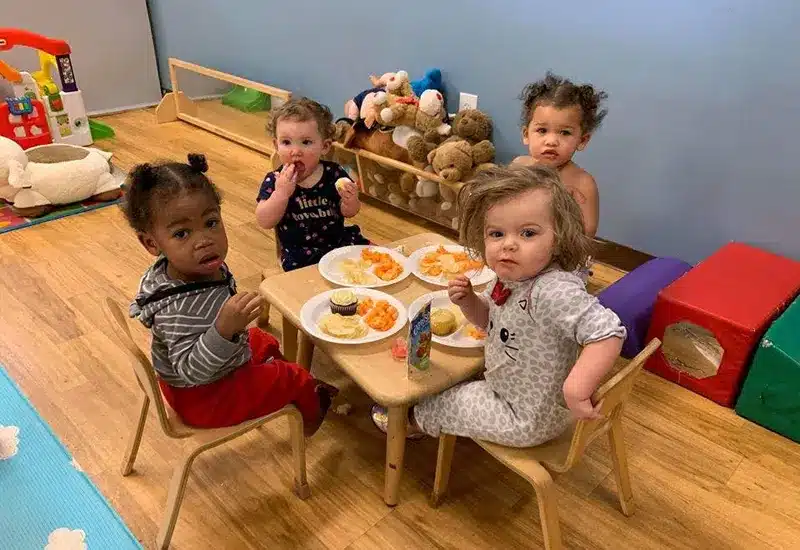
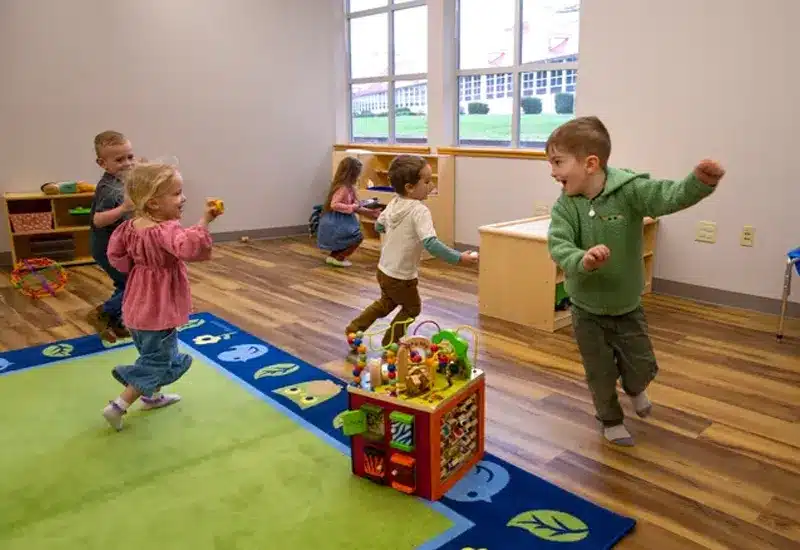
Open Activity Area
This versatile space should accommodate various activities, using modular furniture for easy reconfiguration. Accommodating daycare room setup ideas ensures safety and inclusivity with materials that cater to different interests and stages of development.
Sensory Area
For sensory area daycare room setup ideas, set up a stimulating environment with multi-sensory experiences, including textures, sounds, and interactive elements to encourage exploration and learning through sensory play.


Storage Area
Implement effective storage solutions accessible and safe for adults but secure from children, with clear labeling to maintain organization and facilitate easy clean-up.
Reading Area
A reading area should be a quiet corner with comfortable seating and accessible bookshelves, encouraging children to explore literature. This space should offer a variety of books tailored to different age groups and reading levels, ideally situated away from louder play zones to maintain a calm environment.

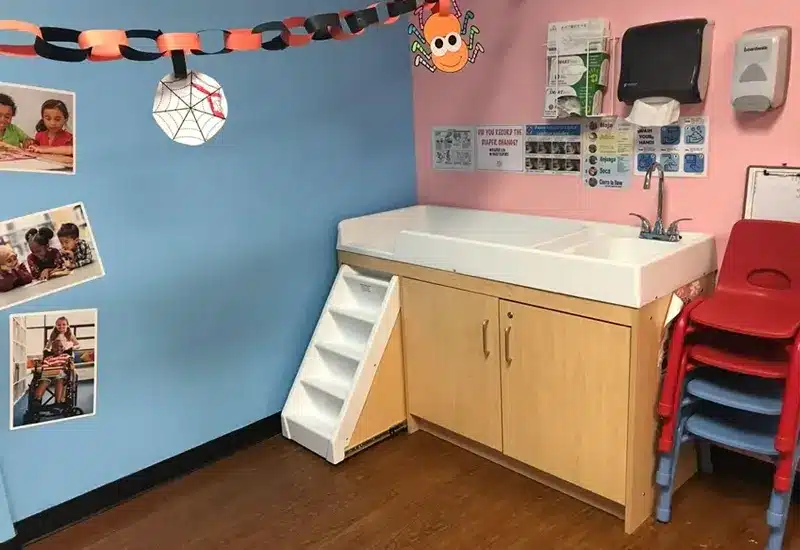
Diaper Changing Area
The diaper changing area needs to be hygienic, with all necessary supplies, including changing tables, diapers, wipes, and sanitizers. This area should be designed for easy cleaning and equipped with features that ensure the safety of both the caregiver and the child.
Outdoor Play Area
When planning your daycare room, don’t forget to consider the outdoors. Outdoor play areas are vital to physical development and should have safe, age-appropriate playground equipment. This area should have supervised, organized play as well as free play.
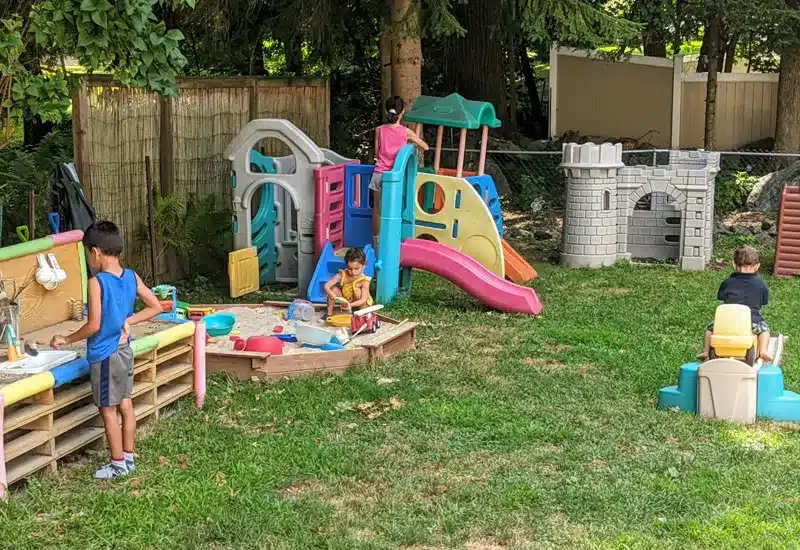
These designated areas are essential for structuring activities in a daycare setting, ensuring that each part of the day is as enriching as possible while keeping operations smooth and seamless. By focusing on the specific needs of these areas, daycare providers can create a more engaging, educational, and safe environment for every child.
3. Daycare Room Setup Ideas – Blending Educational and Sensory Elements
Incorporating educational and sensory elements into a daycare room setup ideas enhances learning and development. Sensory walls with tactile and interactive features stimulate fine motor skills and sensory exploration. Educational mats and themed interactive corners provide a base for playful learning. By integrating sensory-rich and educational items, the environment becomes a dynamic space that supports developmental goals while keeping children engaged.
4. Establish Clear Boundaries
Effective daycare room setup ideas require clear space boundaries to stay organized and safe. Here’s how to establish effective boundaries in a daycare room:
- Room Dividers: Use lightweight, movable dividers to separate different activity areas. These can be themed dividers, like a forest scene for a reading nook or space-themed for a science corner.
- Color Zones: Paint different room areas in various colors to signify different activities. Blue can denote a calm area for reading, while yellow might indicate a play area.
- Floor Markings: Utilize floor tapes or carpets to mark specific areas. These visual cues help children understand where play areas end and eating areas begin, for example.
5. Incorporate Natural Elements

Incorporating natural elements into daycare settings can boost children’s mood and provide a calming, grounded environment. Indoor plants, natural light, and wooden furniture create a welcoming atmosphere that educates children about nature. These elements beautify the space and are integral to creating a healthy, vibrant setting that encourages curiosity and respect for the natural world.
6. Daycare Room Setup Ideas – Wall Decor
There are many different daycare room setup ideas regarding wall decorations. Educational murals can serve as large-scale teaching tools, while shelves for displaying children’s art personalize the space. Interactive elements like magnetic poetry walls and chalkboard paints encourage creativity and self-expression, making the walls decorative and integral to the educational experience.
7. Personalize Your Space with Children’s Art
Personalizing a daycare space with children’s art makes the environment more welcoming and can boost children’s self-esteem. Here’s how to integrate this:

- Art Gallery Area: Dedicate a wall or hallway as a mini-gallery to display new artwork regularly. Seeing their work displayed gives children a sense of accomplishment and joy.
- Rotating Exhibits: Rotate artwork regularly to keep the display fresh and engaging. This also gives every child a chance to have their art featured.
- Themed Display: Create themed display areas where children can contribute art based on current learning topics, seasons, or holidays. This keeps the artwork relevant to their learning experiences.
8. Maximizing Daycare Room Space
To maximize daycare room space, daycare room setup ideas should utilize multi-functional furniture and smart layouts designed to allow for flexibility and maximize floor area. Here are the insights and strategies for expansion:
- Multifunctional Furniture: Invest in furniture that serves multiple purposes. For example, tables with built-in storage can be used for eating, arts and crafts, and store supplies underneath. Similarly, foldable or stackable chairs can save space when not in use.
- Vertical Storage: Utilize vertical space for storage. Shelves up to the ceiling can hold less frequently used items, while hooks and boards can keep everyday items at hand without cluttering the floor.
- Defined Areas: Instead of large, fixed structures, use movable dividers that can be adjusted based on daily needs, allowing the space to be reconfigured for different activities throughout the day.
- Outdoor Extension: If possible, integrate an outdoor area that can be used for some activities. This provides more space and encourages outdoor learning and play, which is beneficial for children’s development.
9. Understanding Children’s Needs and Preferences

To create a truly supportive daycare room environment, a deep understanding and integration of children’s needs and preferences is required. Design age-appropriate spaces that allow for different types of activities appropriate to different stages of development. Incorporating elements that give children choices promotes autonomy and helps develop decision-making skills.
Also, consider children with sensory sensitivities and design spaces that are quieter and less stimulating for them. Gather feedback from children and regularly involve children in room setup decisions. This can be as simple as choosing the color of the curtains or deciding on the furniture arrangement to make them feel valued and part of the community.
10. Considering the Supplies Teachers Need
Daycare room setup ideas should also take into account the needs of teachers. Make sure all necessary supplies are easily accessible, as well as a place for teachers to work and rest.
- Accessible Storage: Place frequently used items in accessible locations. Use clear, labeled bins and drawers to store art supplies, educational materials, and first aid essentials.
- Teacher Stations: Set up dedicated teacher stations where educators can access their planning materials, personal items, and professional tools quickly and efficiently. This could include a small desk area at the side of the room.
- Shared Resource Library: Consider a communal area where resources like books, games, and educational aids can be stored. This encourages sharing and collaboration among staff and keeps resources from being duplicated unnecessarily.
- Feedback Systems: Implement systems where teachers can provide feedback on supplies running low or equipment that needs updating, ensuring that the daycare remains well-stocked and that resources are current.
Safety Considerations for Daycare Room Setup
Safety is paramount when setting up a daycare room and giving parents peace of mind. From furniture to play areas, every element must adhere to strict safety standards to prevent accidents and ensure a safe environment for children.
- Choose non-toxic, durable materials for furniture and play items. Surfaces should be easy to clean and disinfect, reducing the risk of spreading germs.
- Secure all furniture to the wall to prevent it from tipping over, especially in areas where children may climb or pull items.
- Choose round furniture to avoid sharp corners, which can prevent injuries from bumps.
- Floors should be non-slip and padded where necessary, especially in play areas where falls are more likely.
- Clearly mark exits and keep them clear. There is a well-trained emergency plan, including regular drills for staff and children.
- Install adequate lighting and consider placing security cameras. Ensure all areas are visible to staff for easy monitoring.
- Ensure playground equipment is age-appropriate for outdoor playgrounds and set on shock-absorbing material, such as rubber mats or coverings.
- Make sure all toys and learning materials are age-appropriate and free of small parts that could pose a choking hazard.
- Regular safety audits and inspections should be conducted to maintain a safe environment.
What Other Supplies Are Needed for Daycare Room Setup Ideas?
Beyond basic furniture and educational materials, a well-equipped daycare room requires various supplies to support daily activities and ensure cleanliness and organization.
Art supplies like safe, washable paints and markers and ample paper should be on hand for creative projects. Hygiene supplies such as sanitizers, wipes, and tissues are essential to keep the space germ-free, especially in younger children’s rooms. First aid kits must be accessible and fully stocked with supplies to handle minor injuries.
Consider comfort items like soft rugs, pillows, and blankets that create a cozy area for reading or resting. These supplies ensure the daycare room is prepared for various activities and needs, contributing to a functional and adaptive learning environment.
Conclusion
By integrating these creative and functional daycare room setup ideas into your classroom, you can design a safe space, inviting, and adaptable to children’s changing needs. By paying attention to these aspects, daycare centers can become children’s second homes and meet the development of each child.










